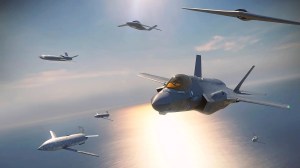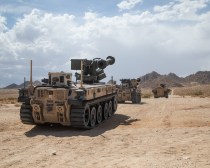‘Democratization’ of technology making it harder for special operators to conduct missions

The proliferation of easily accessible technologies with military applications has made it more difficult for special operations forces to conduct their missions globally, according to a senior commander.
“Democratization of technology is fundamentally changing the future battle spaces,” Lt. Gen. Tony Bauernfeind, vice commander of U.S. Special Operations Command, said during the NDIA SO/LIC Symposium Friday. “We’re seeing right now that there are spaces in the world that we used to have full freedom and access to conduct our operations that we’re challenged on a daily basis, whether that be [unmanned aerial vehicles] challenging our forces, whether that be forces challenging the electromagnetic spectrum, whether that be adversaries are starting getting into biotechnology. That is an area that we have significant concerns.”
New, commercially available tech has limited SOCOM’s ability to operate with the freedom of action they’ve grown accustomed to in previous decades. Additionally, U.S. special operations forces are trying to better prepare themselves for competition and potential conflicts with advanced adversaries such as China.
In the past “we’ve benefited from that full freedom and access and a full support of the Department of Defense to be able to park literally hundreds of airborne [intelligence, surveillance and reconnaissance] aircraft over targets of choice,” Bauernfeind said. “Not only are those resources not available, but I would offer to you that the contested environments are drying up and won’t allow us to do that … We cannot just simply say ‘it’s denied airspace or denied space’ and not enter into it.”
SOCOM is looking to modernize its capabilities. The command has shifted $8 billion over the last three budget cycles to key modernization areas like next-generation ISR and situational awareness, which is essentially a common operating picture.
This paradigm shift has forced the command to innovate in various ways. For example, now there are many more sources for ISR data.
“What’s also happened thanks to industry and the commercial sector is we’ve realized that there are so many more opportunities to get that needed information through other ISR means,” Bauernfeind said. “The fundamental focus of next-generation ISR is an acknowledgment that we’re actually swimming in a sea of data. But how can we take that sea of data and fuse it into information and get it to the leading tactical edge so those warfighters and those ground force commanders and those mission commanders can make those real time decisions they need to when they’re under threat from an adversary in the electromagnetic spectrum is being attacked?”
Next-gen ISR is expected to feed into that situational awareness capability for the force. To do this effectively, SOF will need to leverage automation and artificial intelligence.
Bauernfeind explained that some “SOF peculiar” needs for automation and AI include getting warfighters the information they need at the tactical edge, intelligence fusion for all the data coming in, and ensuring SOCOM has a full understanding of contracts so it can get the most bang for its buck.
To help get a better handle on its data, the command created a new chief data and AI officer and also finalized both a data strategy and implementation plan, Bauernfeind noted.
“It sounds a little bureaucratic, but I will tell you it’s keeping us on pace of how we can start to close out those key requirements that we have for those that have worked in the data world, the AI world. It’s incredibly complicated and you have to have that North Star and you have to have that plan to start knocking down targets as we go going forward,” he said.






